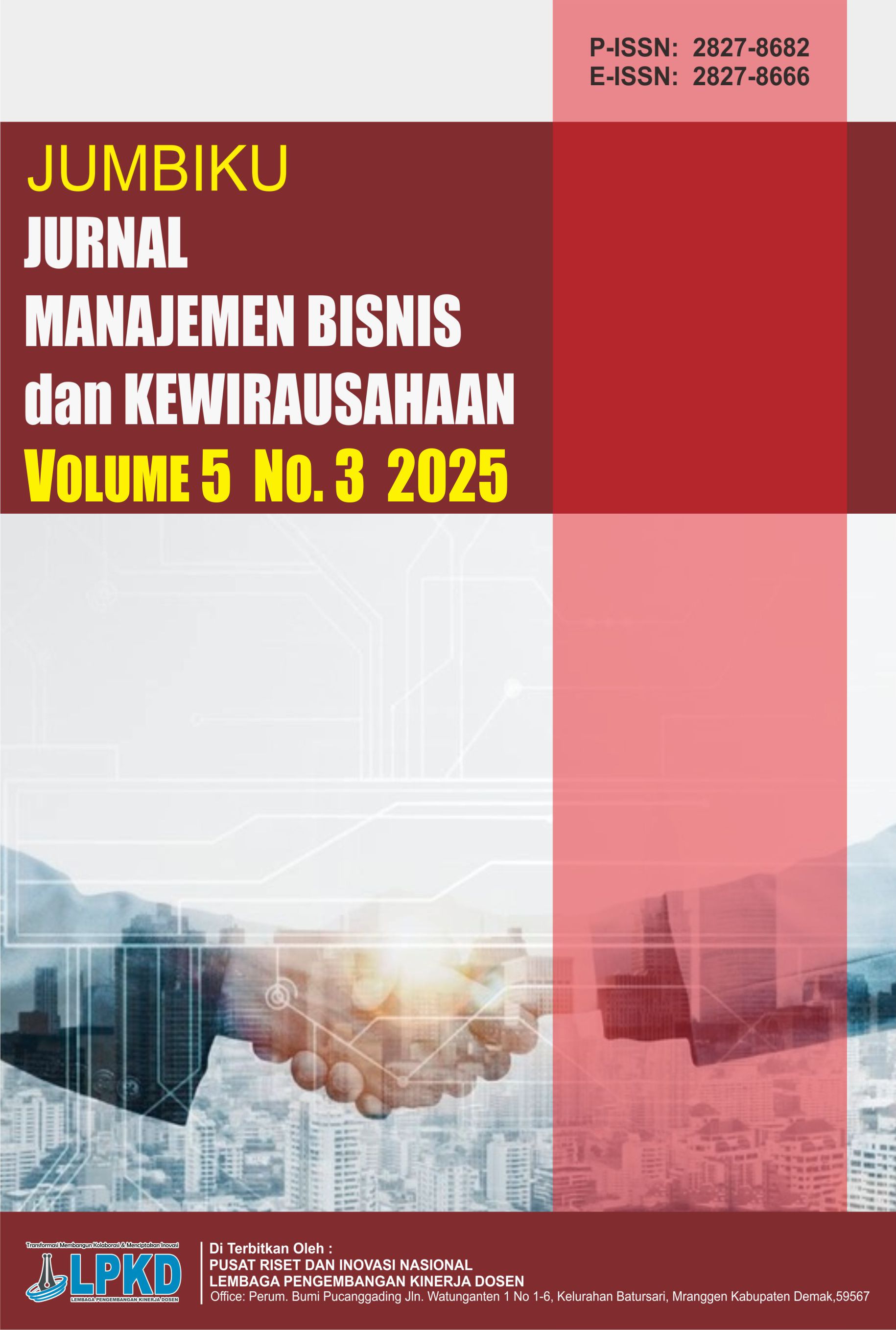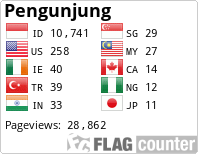Pengaruh Value Added of Capital Employed, Value Added Human Capital dan Structural Capital Value Added terhadap Nilai Perusahaan F&B
DOI:
https://doi.org/10.55606/jumbiku.v5i3.6105Keywords:
F&B Sector, Firm Value, Intellectual Capital, Linear Regression, Structural CapitalAbstract
This study examines the influence of Value Added of Capital Employed (VACE), Value Added Human Capital (VAHC), and Structural Capital Value Added (SCVA) on firm value in Indonesia’s Food and Beverage (F&B) sector from 2022 to 2024. The research is driven by the growing significance of intellectual capital in boosting competitiveness and firm value, particularly in the rapidly transforming and digitalized F&B industry. A quantitative methodology was adopted, utilizing secondary data from the financial statements of F&B companies selected through purposive sampling. The data were analyzed using multiple linear regression, supplemented with classical assumption tests to validate the model. Key findings indicate that, collectively, the three independent variables significantly impact firm value. However, only SCVA demonstrates a positive and significant partial effect. The coefficient of determination (R²) of 26.1% suggests that the model accounts for a portion of the variation in firm value, leaving 73.9% attributable to external factors beyond the model’s scope. These results underscore the strategic importance of enhancing structural capital—through advancements in systems, technology, and organizational processes—as a means to elevate firm value in the F&B industry.
Downloads
References
Adha, L. A. (2020). Digitalisasi industri dan pengaruhnya terhadap ketenagakerjaan dan hubungan kerja di Indonesia. Journal Kompilasi Hukum, 5(2), 267–298. https://doi.org/10.29303/jkh.v5i2.49
Andi Yusniar Mendo, Biki, S. B., Sawitri Pilomonu, M. R., Suronoto, M. D., & Humulungo, A. R. (2025). Analisis kebutuhan dan rancangan program digital upskilling bagi fresh graduate di Provinsi Gorontalo. Reslaj: Religion Education Social Laa Roiba Journal, 7(1). https://doi.org/10.47467/reslaj.v7i1.5487
Bank Permata. (2023). Laporan pertumbuhan produk domestik bruto sektor makanan dan minuman kuartal pertama 2023.
Bontis, N. (1998). Intellectual capital: An exploratory study that develops measures and models. Management Decision, 36(2), 63–76. https://doi.org/10.1108/00251749810204142
Cahyadi, O., & Anggraeni, F. (2024). Pengaruh value added terhadap nilai perusahaan non keuangan. E-Jurnal Akuntansi TSM, 3(4), 269–278. https://doi.org/10.34208/ejatsm.v3i4.2296
Cekindo. (2024). Laporan tahunan pertumbuhan sektor makanan dan minuman di Indonesia tahun 2022.
Chi, C. W., Lieu, P. T., Hung, K., & Cheng, H. W. (2016). Do industry or firm effects drive performance in Taiwanese knowledge-intensive industries? Asia Pacific Management Review, 21(3), 170–179. https://doi.org/10.1016/j.apmrv.2016.05.001
Chowdhury, L. A. M., Rana, T., Akter, M., & Hoque, M. (2018). Impact of intellectual capital on financial performance: Evidence from the Bangladeshi textile sector. Journal of Accounting & Organizational Change, 14(4), 429–454. https://doi.org/10.1108/JAOC-11-2017-0109
CRIF Asia. (2024). Data kontribusi sektor makanan dan minuman terhadap produk domestik bruto Indonesia tahun 2024.
Dancaková, D., & Glova, J. (2024). The impact of value-added intellectual capital on corporate performance: Cross-sector evidence. Risks, 12(10), 151. https://doi.org/10.3390/risks12100151
Deniswara, K., Uyuun, R. M. F., Lindawati, A. S. L., & Willnaldo, W. (2019). Intellectual capital effect, financial performance, and firm value: An empirical evidence from real estate firm in Indonesia. The Winners, 20(1), 49. https://doi.org/10.21512/tw.v20i1.5500
Edvinsson, L., & Malone, M. S. (1997). Intellectual capital: The proven way to establish your company's real value by measuring its hidden brainpower. Piatkus.
Extevanus, L., & Habiburahman, H. (2024). Pengaruh intellectual capital terhadap kinerja keuangan pada perusahaan manufaktur sub sektor food and beverage yang terdaftar di Bursa Efek Indonesia tahun 2019–2022. Journal of Information System, Applied, Management, Accounting and Research, 8(1), 187. https://doi.org/10.52362/jisamar.v8i1.1440
Garlinia, H. Y., Manurung, D. T. H., & Husnatarina, F. (2018). Relationship between value added capital employed, value added human capital, structural capital value added and financial performance. Investment Management and Financial Innovations, 15(2), 222–231. https://doi.org/10.21511/imfi.15(2).2018.20
Ghadah, G., Mufidah, M., Masnun, M., Febrianti, I., & Adisetiawan, R. (2024). Pengaruh value added of capital employed, human capital structural capital value added, intellectual coefficients, return on assets terhadap nilai perusahaan. Ekonomis: Journal of Economics and Business, 8(1), 854. https://doi.org/10.33087/ekonomis.v8i1.1788
Madumere, I., & Ihenacho Ubani, G. (2023). Intellectual capital and financial performance of deposit money banks in Nigeria. SSRN Electronic Journal. https://doi.org/10.2139/ssrn.4282194
Marzo, G. (2022). A theoretical analysis of the value added intellectual coefficient (VAIC). Journal of Management and Governance, 26(2), 551–577. https://doi.org/10.1007/s10997-021-09565-x
Mendo, A. Y., Biki, S. B., & Yasin, A. A. (2024). Pengaruh kualitas pelayanan dan budaya kerja terhadap kepuasan pengunjung pada objek wisata Hiu Paus Botubarani. Innovative: Journal of Social Science Research, 4(2).
Musa, R., Mendo, A. Y., & Biki, S. B. (2024). Pengaruh pengembangan sumber daya manusia terhadap kinerja pengelola wisata Hiu Paus di Desa Botubarani Kab. Bone Bolango. Innovative: Journal of Social Science Research, 4(2).
Oktaviani, C. E. P., Janah, I., & Purdianto, A. (2025). The influence of value added capital employed (VACA) and structural capital value added (STVA) on return on assets (ROA) at Indonesian government banks. Indonesian Journal of Business Analytics, 5(3), 2748–2767. https://doi.org/10.55927/ijba.v5i3.14683
Olarewaju, O. M., & Msomi, T. S. (2021). Intellectual capital and financial performance of South African Development Community's general insurance companies. Heliyon, 7(4), e06712. https://doi.org/10.1016/j.heliyon.2021.e06712
Pulic, A. (2000). VAIC™: An accounting tool for IC management. International Journal of Technology Management, 20(5–8), 702. https://doi.org/10.1504/ijtm.2000.002891
Purwanti, A. (2019). The role of return on assets on the effect of value added capital employed towards business growth. Proceedings of the 5th Annual International Conference on Accounting Research (AICAR 2018). https://doi.org/10.2991/aicar-18.2019.17
Putri, A. A. (2024). The effect of value-added human capital, structural capital value-added, value-added capital employed, and profitability on firm value with firm size as a moderating variable (Study of manufacturing companies in the sub-sector pharmaceuticals listed on the IDX). International Journal of Economic, Business & Applications, 9(1), 59–80. https://doi.org/10.31258/ijeba.95
Quaralia, P. S. (2022). Kerjasama regional dalam rantai pasokan pertanian untuk mencapai ketahanan pangan berkelanjutan: Studi kasus ASEAN. Padjadjaran Journal of International Relations, 4(1), 56. https://doi.org/10.24198/padjir.v4i1.37614
Rika Yuniarti, Muslim, A. I., & Chairunnas, A. (2024). Pengaruh value added capital employed (VACA), value added human capital (VAHU), structural capital value added (STVA) terhadap PBV pada perusahaan perkebunan yang terdaftar di Bursa Efek Indonesia. Jurnal Riset Akuntansi Aksioma, 23(2), 333–344. https://doi.org/10.29303/aksioma.v23i2.445
Savila, I. D., & Chariri, A. (2025). Optimalisasi kinerja inovasi: Mengungkap pengaruh intellectual capital terhadap nilai perusahaan. Owner, 9(2), 965–976. https://doi.org/10.33395/owner.v9i2.2632
Sena, T., & Zenabia, T. (2025). Pengaruh intellectual capital, keputusan investasi dan kinerja keuangan terhadap nilai perusahaan multinasional sektor non-cyclicals yang terdaftar di BEI (periode 2019–2023). Jurnal Nusa Akuntansi, 2(2), 1028–1051. https://doi.org/10.62237/jna.v2i2.251
Setiawan, R., & Prawira, B. Y. (2018). Intellectual capital and the performance of manufacturing companies in Indonesia. JMM UNRAM - Master of Management Journal, 7(3), 13–28. https://doi.org/10.29303/jmm.v7i3.312
Sowaity, S. M. A. (2022). Does intellectual capital efficiency affect earnings quality? Evidence for Jordanian listed companies. Open Journal of Accounting, 11(2), 80–109. https://doi.org/10.4236/ojacct.2022.112006
Ståhle, P., Ståhle, S., & Aho, S. (2011). Value added intellectual coefficient (VAIC): A critical analysis. Journal of Intellectual Capital, 12(4), 531–551. https://doi.org/10.1108/14691931111181715
Statista. (2025). Proyeksi pertumbuhan industri makanan dan minuman di Indonesia 2023–2025.
Sveiby, K. E. (1999). The new organizational wealth: Managing & measuring knowledge-based assets. Berrett-Koehler.
Tran, N. P., & Vo, D. H. (2020). Human capital efficiency and firm performance across sectors in an emerging market. Cogent Business & Management, 7(1), 1738832. https://doi.org/10.1080/23311975.2020.1738832
Downloads
Published
How to Cite
Issue
Section
License
Copyright (c) 2025 Jurnal Manajemen, Bisnis dan Kewirausahaan

This work is licensed under a Creative Commons Attribution-ShareAlike 4.0 International License.








